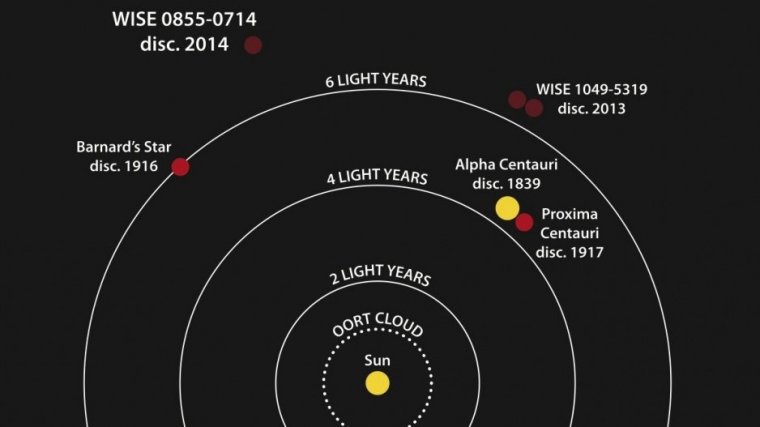| News / Science News |
A cold, close neighbor of the Sun
NASA | APRIL 27, 2014
NASA's Wide-field Infrared Survey Explorer (WISE) and Spitzer Space Telescope have discovered what appears to be the coldest "brown dwarf" known -- a dim, star-like body that surprisingly is as frosty as Earth's North Pole. Named "WISE J085510.83-071442.5," the brown dwarf appears to be 7.2 light-years away, earning it the title for fourth closest system to our sun.

This diagram illustrates the locations of the star systems closest to the sun. Image credit: Penn State University
Brown dwarfs start their lives like stars, as collapsing balls of gas, but they lack the mass to burn nuclear fuel and radiate starlight. The newfound coldest brown dwarf is named WISE J085510.83-071442.5.
It has a chilly temperature between minus 54 and 9 degrees Fahrenheit (minus 48 to minus 13 degrees Celsius). Previous record holders for coldest brown dwarfs, also found by WISE and Spitzer, were about room temperature.
WISE was able to spot the rare object because it surveyed the entire sky twice in infrared light, observing some areas up to three times. Cool objects like brown dwarfs can be invisible when viewed by visible-light telescopes, but their thermal glow -- even if feeble -- stands out in infrared light. In addition, the closer a body, the more it appears to move in images taken months apart. Airplanes are a good example of this effect: a closer, low-flying plane will appear to fly overhead more rapidly than a high-flying one.
The closest system to Earth, a trio of stars, is Alpha Centauri, that consists of Alpha Centauri, a close companion to it and the more distant companion Proxima Centauri, at about 4 light-years away. WISE J085510.83-071442.5 is only a few light years farther than that.
WISE J085510.83-071442.5 appears to be 3 to 10 times the mass of Jupiter. With such a low mass, it could be a gas giant similar to Jupiter that was ejected from its star system. But scientists estimate it is probably a brown dwarf rather than a planet since brown dwarfs are known to be fairly common. If so, it is one of the least massive brown dwarfs known.
YOU MAY ALSO LIKE





